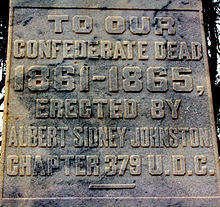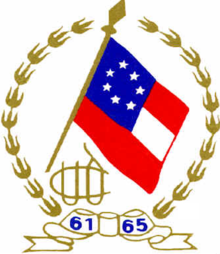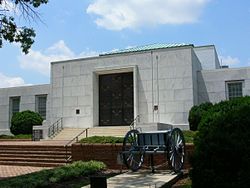- United Daughters of the Confederacy
-
The United Daughters of the Confederacy (UDC) is a women's heritage association dedicated to honoring the memory of those who served in the military and died in service to the Confederate States of America (CSA). UDC began as the National Association of the Daughters of the Confederacy, organized in 1894 by Caroline Meriwether Goodlett and Anna Davenport Raines. It was related to older heritage associations such as the Daughters of the Confederacy in Missouri and the Ladies’ Auxiliary of the Confederate Soldiers Home in Tennessee.
The National Association changed its name to the UDC in 1895. It was incorporated under the laws of the District of Columbia in 1919. Its motto is “Love, Live, Pray, Think, Dare”.
Contents
Membership
Membership in UDC is open to women at least 16 years old who are of lineal or collateral blood descent from veterans who served honorably in the Army, Navy, or Civil Service of the CSA or are current or former members of UDC.
Membership is through a local chapter, usually where the prospective member resides. Local chapters come under the auspices of the state or "Division".
There are currently 33 states with active chapters.
Objectives
According to its original founding, the objectives of the organization are Historical, Educational, Benevolent, Memorial and Patriotic:
- To collect and preserve the material necessary for a truthful history of the War Between the States and to protect, preserve, and mark the places made historic by Confederate valor;
- To assist descendants of worthy Confederates in securing a proper education;
- To fulfill the sacred duty of benevolence toward the survivors of the War and those dependent upon them;
- To honor the memory of those who served and those who fell in the service of the Confederate States of America;
- To record the part played during the War by Southern women, including their patient endurance of hardship, their patriotic devotion during the struggle, and their untiring efforts during the post-War reconstruction of the South; and
- To cherish the ties of friendship among the members of the Organization.[1]
Headquarters
United Daughters of the Confederacy Memorial BuildingLocation: 328 North Blvd., Richmond, Virginia Area: less than one acre Built: 1955 Architect: Louis W. Ballou Architectural style: Stripped Classical Governing body: Private NRHP Reference#: 08000341
[2]Added to NRHP: April 24, 2008 Memorial Hall, the headquarters of the UDC, is located in Richmond, Virginia. The United Daughters of Confederacy collects and preserves rare books, documents, diaries, letters, and other papers of historical importance that relate to the American Civil War period. The collection is kept in Goodlett Memorial Library at the headquarters.
History
See also: Memorial DayAt a time of increasing fraternal and civic organizations in the United States, the UDC grew rapidly with local and state chapters. By 1900 it had 20,000 members; and by the end of World War I (1914–1918), its numbers had grown to nearly 100,000 women.[3] It was part of an end of the century revival of national sentiment about being American.
Beginning soon after the war, women's groups were active in local areas in raising money to establish cemeteries for the many Confederate war dead. In the immediate aftermath of the war, the numbers had been overwhelming, federal resources were devoted to the Union dead, and private groups led the efforts for appropriate burials and care of the Confederate dead. Such groups were part of the origin of the UDC.[4] In addition to arranging for reburial of soldiers in the South, they funded and organized memorials to Confederate veterans and battles.[4] They were instrumental in organizing to commemorate the war, including annual events in many towns across the South. They led the struggle to shape memory in the aftermath of the war.[5] They also raised money to care for the widows and children of the Confederate dead. As the Encyclopedia Virginia says of the organization, "The context of these efforts was the Lost Cause interpretation of the Civil War, which emphasized states' rights and secession over slavery as causes of the war and was often used to further the goals of white supremacists in the twentieth century."[3]
During the twentieth century, the UDC members participated in battles over the content of textbooks and how history would be taught in the South. This included controversy over how the war would be named. In the South, it was taught as the "War between the States". In their version, all the slaves were loyal and willingly contributed to the Cause. In the 1920s and 1930s, the UDC tried to organize a monument to "faithful slaves", to be built on the Mall in Washington, DC.[3] Blacks strongly objected to this; in 1923 two thousand women of the Phyllis Wheatley YWCA protested with a resolution to Vice President Calvin Coolidge and House Speaker Gillette.[6]
During World War I, the UDC supported 70 hospital beds at the American Military Hospital at Neuilly-sur-Seine, France and contributed $82,069 for French and Belgian orphans. At home, the UDC members purchased $24,843,368 worth of war bonds and savings stamps. They also donated $841,676 to the Red Cross.
During World War II, the organization assisted the National Nursing Association by donating financially to student nurses until the United States Congress passed the Bolton Act, which created the first Cadet Nurse Corps. Through the Red Cross, the UDC donated ambulances for use at European battle sites and a blood plasma unit. They were commended by the Red Cross for their outstanding contributions to the war.
In the years of rising activism by African Americans for civil rights, the UDC opposed Brown v. Board of Education (1954), the U.S. Supreme Court decision that ended legal segregation of public schools. Many of its chapters participated in the Massive Resistance in Virginia and other states. In 1959 the UDC in Jacksonville, Florida supported renaming an all-white public high school after General Nathan Bedford Forrest, a Confederate hero and post-Civil War elected leader of the Ku Klux Klan.[7] By the 21st century, the school's demographics had changed. Its students are now 54 percent African American. Although many local residents (and the students) wanted to change the name of the high school, in November 2008, the Duval County school board (which controls the county facilities) voted to keep the name. Its five white members voted for the measure, and the two African-American members voted against it.[7]
The association's work on memorials and memory has continued. For instance, during the 1950s, the UDC raised funds to commission window memorials to the Confederate generals Robert E. Lee and Thomas Jonathan "Stonewall" Jackson for the National Cathedral in Washington, D.C. They were installed in 1957. The tracery windows depict episodes in the lives of each of the generals.
Scholarships and awards
- Mrs. Simon Baruch University Award - $500 to the author and $2000 toward publication of an unpublished monograph or full-length book on Confederate history. The award was endowed in 1925 by the financier Bernard Baruch in memory of his mother Belle, whose husband Simon Baruch was a Confederate surgeon on Robert E. Lee's staff; she was an early member of the UDC.
- Annabella Drummond McMath Scholarship, to aid women over the age of 30 begin or continue their education.
Recent issues
Unlike the Daughters of the American Revolution, the UDC has made no provision for officially acknowledging the contributions of enslaved blacks during the war. For some time, their emphasis on preserving "Southern heritage" was seen to stand for a desire for white supremacy and rigid caste.
- James McPherson: During a radio interview in 1999, Princeton University historian James M. McPherson, a scholar of the Civil War, associated the (UDC) with the neo-Confederate movement and described board members of the Museum of the Confederacy in Richmond, Virginia as "undoubtedly neo-Confederate". He said that the UDC and their male counterparts, the Sons of Confederate Veterans (SCV), have "white supremacy" as their "thinly veiled agendas."[8]
Some members of the UDC and the SCV were outraged and stated that the two organizations do not have a racist agenda. Some SCV and UDC chapters urged their members to boycott McPherson's books and engage in letter-writing campaigns of protest.[9] McPherson responded that he did not mean to imply that all SCV or UDC chapters, or everyone who belongs to them, promote the agenda. He further stated that (only) "some of these people have a hidden agenda [which] they might not even recognize they're involved in."[9]
- In 2003 Essie Mae Washington-Williams announced that she was the natural daughter of Strom Thurmond (which his family confirmed), born in 1925 when he was 22 and her mother Carrie Butler was 16 and a housekeeper at his parents' house. In 2004 Washington-Williams announced her intention to join the UDC. Thurmond had completed the documentation and long been a member of the corresponding Sons of Confederate Veterans. She encouraged other African Americans to participate as well, to learn more about their heritage and add to the full story of American history.[10]
 UDC memorial on the lawns of University_of_Mississippi
UDC memorial on the lawns of University_of_Mississippi
- Vanderbilt University Confederate Memorial Hall:
 Confederate Memorial Hall, located on Vanderbilt University's Peabody campus.
Confederate Memorial Hall, located on Vanderbilt University's Peabody campus.
The UDC sued Vanderbilt University, located in Nashville, Tennessee over its 2002 plan to change the name of Confederate Memorial Hall, a student dormitory. In September 2002, the university announced its intention to remove "Confederate" from the pediment of the building in recognition of changed times. The UDC sued, as it had funded one third of the cost in 1935 when the building was constructed. Its condition was that the building would be named Confederate Memorial Hall and have two floors reserved for women descendants of Confederate veterans.
After a lengthy legal process that went to appeal, the Tennessee State Appeals Court ruled on May 3, 2005, that Vanderbilt University would be forced to pay a sizeable sum to the UDC if it removed "Confederate" from the building.[11] Due to the court ruling, the university decided against formally changing the name. In its materials, the university refers to the building simply as Confederate Memorial Hall.
See also
- Daughters of the American Revolution
- DeLeon Plaza and Bandstand
- Grand Army of the Republic
- McGavock Confederate Cemetery
- Military Order of the Stars and Bars
- Naming the American Civil War
- Sons of Confederate Veterans
References
- ^ United Daughters of the Confederacy Home Page
- ^ "National Register Information System". National Register of Historic Places. National Park Service. 2009-03-13. http://nrhp.focus.nps.gov/natreg/docs/All_Data.html.
- ^ a b c Caroline E. Janney, "United Daughters of the Confederacy", Encyclopedia Virginia, 2010, accessed 22 March 2011
- ^ a b Drew Gilpin Faust, This Republic of Suffering: Death and the American Civil War, New York: Alfred A. Knopf, 2008, pp. 237-247
- ^ David W. Blight, Race and Reunion: The Civil War in American Memory, Cambridge, MA: Harvard University Press, 2001
- ^ Joan Marie Johnson, "Ye Gave Them a Stone", Journal of Women's History
- ^ a b Jennifer Lawinski (2008-11-07). "Florida High School Keeps KKK Founder's Name". FOXNews.com. http://www.foxnews.com/story/0,2933,448684,00.html. Retrieved 2008-11-07.
- ^ "James McPherson Interview", Pacifica Radio
- ^ a b "Princeton Educator Maligns UDC", Virginia Division, United Daughters of the Confederacy
- ^ "Daughter of late Sen. Strom Thurmond to join Confederacy group", Jet, 19 Jul 2004, accessed 26 Mar 2009
- ^ "Confederate Memorial Hall UPDATE: Court of Appeals Soundly Reverses Trial Court". Schulman, Leroy & Bennett, P.C.. 2005-05-03. http://www.slblawfirm.com/slbweb/cases/cases.html. Retrieved 2008-06-20.
Further reading
- Cox, Karen L. Dixie's Daughters: The United Daughters of the Confederacy and the Preservation of Confederate Culture. Gainesville: University Press of Florida, 2003.
- Foster, Gaines M. Ghosts of the Confederacy: Defeat, the Lost Cause, and the Emergence of the New South. New York: Oxford University Press, 1987.
- Janney, Caroline. Burying the Dead but not the Past: Ladies' Memorial Associations and the Lost Cause. Chapel Hill: University of North Carolina Press, 2008.
- Parrott, Angie. "'Love Makes Memory Eternal': The United Daughters of the Confederacy in Richmond, Virginia, 1897–1920," in Edward Ayers and John C. Willis, eds. The Edge of the South: Life in Nineteenth-Century Virginia, Charlottesville: University Press of Virginia, 1991, 219–38.
External links
Categories:- 1894 establishments
- American Civil War veterans and descendants organizations
- Confederate States of America
- Fraternal service organizations
- Historical societies
Wikimedia Foundation. 2010.


